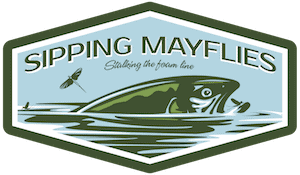A GUIDE TO FLY FISHING IN RIFFLES
Dec. 2nd, 2021
Riffles are the lifeblood of a river or stream, and yet many fly anglers wouldn’t be able to identify one out on the water. It’s vital that you understand this section of a river if you’re going to be catching fish. Fly fishing in riffles can help you greatly improve your odds of hooking into more trout.
In this article I’ll explain how to identify a riffle, why a riffle is rich with life, how and when to fly fish in a riffle, and what flies to use. It’ll be simple to understand, and well worth your time.
In the abbreviated riffle below, I hooked into and landed eight big brown trout within about 20 minutes. Riffles can be super productive!
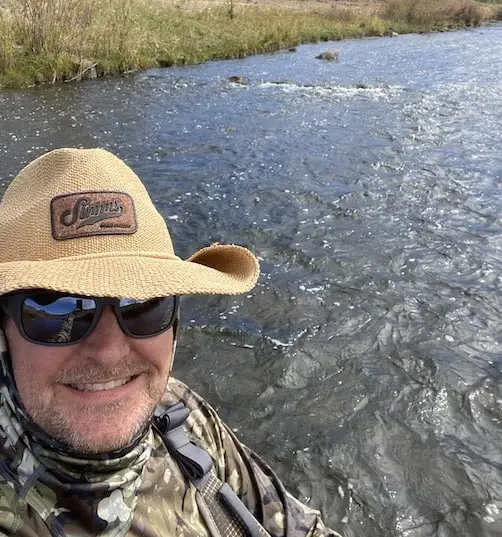
How to Identify a Riffle
Riffles are easy to spot. They’re like many things—once you see one, you’ll recognize them everywhere. Fly fishing in riffles is generally much more productive than other sections of a river, so take your time and read on.
Rivers are made up of various sections, such as runs, pools, pocket water, and riffles.
Runs are longer stretches of water, sometimes hundreds of yards or even miles long. They’re deeper than riffles, and somewhat featureless.
Pools are just what you’d imagine—deeper sections of a river where the water seems to slow to a crawl. Sometimes the current isn’t even detectable in a pool, and the surface can look like glass. Pools are the deepest part of a river, often 8-10 feet deep, and sometimes over 20-feet deep.
Pocket water is a section of the river or stream where protruding boulders and large rocks are peppered across the water, creating “pockets” of slower and faster water. Pocket water can exist in the midst of a riffle or run.
Here’s a picture I took of some beautiful pocket water. In fact, I caught a pretty little rainbow trout in front of the far-right boulder.
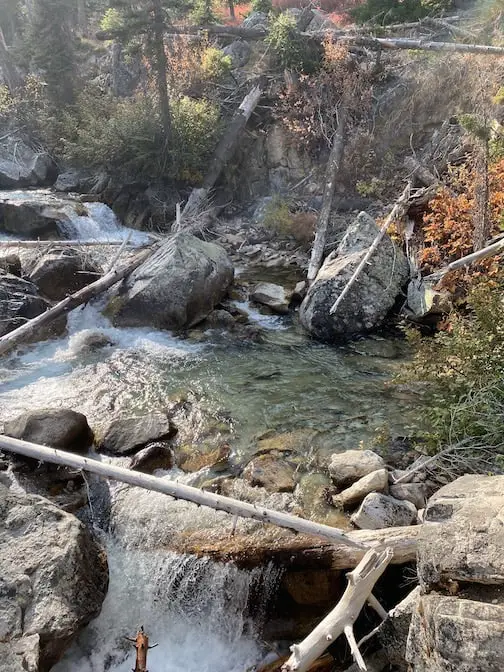
So, what is a riffle?
Riffles are sections of a river or stream where the water is shallow and moving at a quick pace—faster than the surrounding water. This is because the river’s flow is being constricted into a smaller area (shallower), and so it’s forced to flow faster.
Keep an eye out for choppy water. Choppy water is always a telltale sign of a riffle.
While I was wading, I took the below picture of a riffle. If the surface of the water is visibly turbulent, there’s a good chance you’re approaching a riffle.
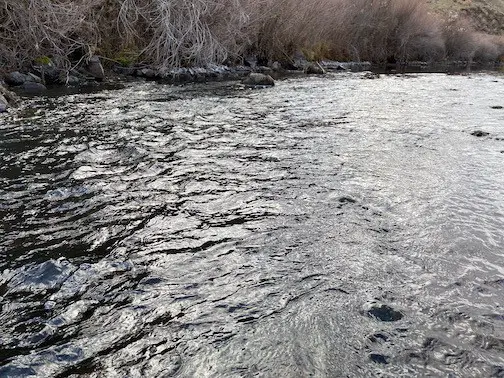
How shallow is a riffle? There is no specific definition, but most riffles are anywhere from 8 to 18 inches deep. There are exceptions, but I’m speaking in a general sense.
The water’s surface is always slightly choppy in a riffle. This turbulence is caused by subsurface currents cascading off of submerged rocks and stones.
Riffles often times have smaller rocks breaking the surface, but riffles can’t be pigeonholed this way. There are plenty of riffles that have no rocks breaking the surface at all.
The length of a riffle can be as short as few feet, or as long as hundreds of yards.
Here’s a video I took of the same riffle shown in the above picture. Video makes it easier to convey how to spot riffles because you can observe the water’s motion.
Why you should be fly fishing in riffles
As I mentioned earlier, riffles are the most productive sections of water in any river. Take that in. Let it marinate.
Fish gather in riffles for a few reasons, which I’ll detail for you as we progress.
The turbulent water translates to more surface area coming into contact with air, which acts as a type of aeration. The active current means this oxygen gets quickly dispersed throughout the water column. This means the oxygen content is consistently higher in a riffle than any other part of a river or stream.
Since riffles are shallow, you might wonder why trout would put themselves in such a vulnerable position when it comes to potential predators. But, things aren’t as they appear.
A riffle’s choppy water actually makes it more difficult for predators to see clear images of the fish from above, making it a relatively secure environment. Conversely, the opposite is also true—the fish can’t see out of the water nearly as well.
Here’s a big brown trout I caught while fly fishing in a shallow riffle (+/-12 inches deep) using a pheasant tail nymph. If you’re interested in learning more, check out my article on fly fishing for brown trout.
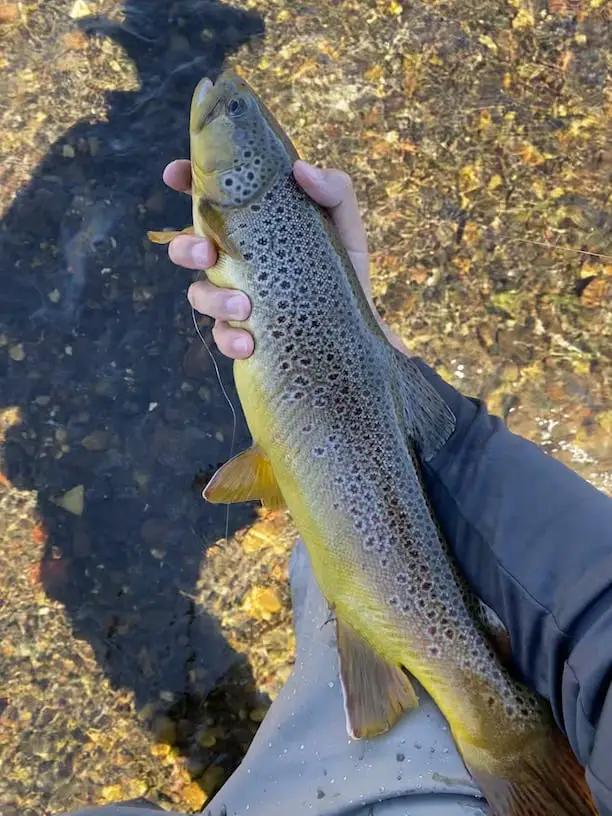
So, we’ve talked about the highly oxygenated water, but riffles also have another huge advantage: the shallow water allows the sun’s rays to easily penetrate all the way to the bottom.
This is important because the sunlight promotes explosive vegetative growth. To be clear, riffles are rarely full of weeds and plants, but they do contain small plants and plenty of algae.
Insects are drawn to riffles because of the higher oxygen levels and prime egg-laying environment, making riffles an excellent food source for trout. Minnows and sculpins are also drawn to the rich insect life.
Holding a position within a riffle does require some calories on the fish’s part, but it’s well worth the effort. Jeremy Wade of River Monsters once equated fish to underwater accountants. He said that their inputs must exceed their outputs, or they go bankrupt. Well said.
It’s fair to say that riffles are a prime location for all trout, based on the availability of food and oxygen. Now that we understand why trout are attracted to riffles, and why you should focus your fly fishing in riffles, let’s talk about how to catch them.
How to fly fish in riffles
One of the beautiful things about riffles is that they’re really easy to wade. Some riffles are slow, others are fast, but they’re always shallow.
When you’re fly fishing in riffles, unless you’re swinging flies or streamers, you’ll generally want to work your way upstream from the bottom (end) of the riffle. This isn’t the only method, but it’s the most common.
I recommend using a 9-foot, 5-weight fly rod with weight-forward floating line.
This rod outfit will allow you to cast dry flies, small streamers, wet flies, and nymphs. If you’re going to focus solely on nymphs, you may want to go up to a 10 or 10 ½ foot rod since the added length will help you with your positioning.
One of the largest brown trout I’ve ever landed was in a riffle eight inches deep, in bright sun. There are plenty of folks who would’ve said, “Don’t waste your time in that water.”
My point is that you need to experiment, rather than follow regurgitated advice. Mark my words—there are very few, if any, universal truths in fly fishing. Don’t let anyone tell you you’re doing something wrong. If it’s working for you, you’re not doing it wrong.
Riffles, because of their shallow water, provide the opportunity to sight fish for trout. Sight fishing adds an element of excitement that isn’t easily duplicated. It’s riveting.
Spotting trout in a riffle isn’t always easy. Watch for their rythmic back-and-forth tail movement as they hold their position.
Once in a great while I see trout “parked” on the bottom almost motionless, holding their spot by anchoring their tail on the substrate. The first time I saw this I thought the trout (a rainbow) must’ve been sick. It seemed so unnatural. I waded up to within inches before it quickly swam upstream.
The below picture is a nice brown trout that took one of my dry flies in a riffle.
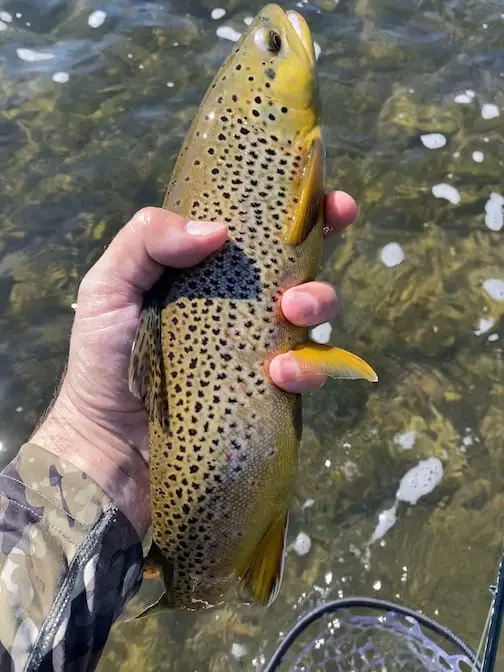
A dry-dropper setup (dry fly trailed by a nymph) can be very productive in a riffle, giving trout the option of rising or taking something below the surface. The trout will take the nymph over the dry fly most of the time, but certainly not always.
Very recently I was in the mountains fly fishing in a riffle of crystal clear water that was just 10-12 inches deep. The afternoon sun was warm, and the trout were active.
I happened to notice a large brown trout (+/-19 inches) holding in the water just ten feet away from where I was standing. It didn’t spook, no matter what movements I made. Why?
Do you remember when I mentioned that fish can’t see through the choppy water’s surface very well? Light bends when it penetrates water, even still water. So, imagine how much light bends when the surface of the water is turbulent. The view from underwater is very contorted.
If you’re curious what I mean, put on a snorkel mask and go underwater, then turn and look up at the surface.
The other reason the big brown didn’t notice me is because when trout are in shallow water, their view of the outside world is severely narrowed. When trout are deeper in the water column, their view of the outside world (ie. you) widens substantially.
This means in a riffle you can approach trout much closer than would otherwise be tolerated. A huge advantage. This of course holds true for any choppy water in a river, not just in a riffle.
Even if you do spook the trout, just take a seat on the shoreline and eat your lunch, take a nap, or read a book, for 20 minutes. Most trout should return in that amount of time. Some won’t, but enough will. They can’t afford to stop eating for too long.
This stout little rainbow trout took my elk hair caddis fly while I was casting near a downed tree that was laying across a riffle.
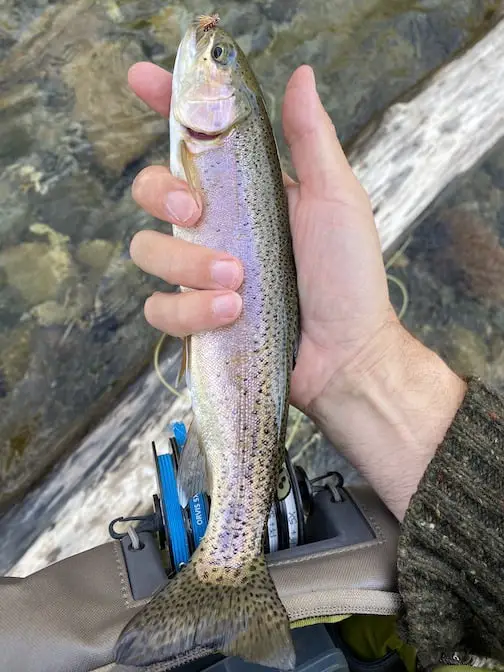
Back to the story.
I was casting a dry-dropper to the big brown trout, and it would rise towards my dry fly every so often, but then drift back down into position. It completely ignored my nymph every time.
There was no drag in my presentation, so I kept pondering my options. A cast or two later, my flies again drifted untouched past the big brown. But two feet behind the fish I was targeting, another big brown trout rose and inhaled my dry fly.
It was a nice 17-incher. A serendipitous event, although the commotion did spook the bigger trout. Fly fishing riffles is time well spent on the water.
I hadn’t even noticed the second trout behind the first one, mainly because of the turbulent surface of the water. The lesson here is to never underestimate how many fish a riffle can hold.
Another tactic for fishing in a riffle is to use a double-nymph rig. Nymph rigs are a little clunky, but they can be deadly effective. And, in a riffle, you’d rarely be casting long distances.
Specifically, tie on one (or two) nymphs below your indicator (bobber) and let them drift drag-free down the riffle.
Here’s something useful I learned from the book Dynamic Nymphing.
If you’re using two nymphs, you’ll need to watch even more carefully for a take because you now have a hinge in your setup. The “hinge” point is the nymph between your indicator and the trailing nymph. Try to envision it. If a trout takes the trailing nymph, the take isn’t transmitted directly to your indicator—it’s partially muted by the hinge point.
Experiment with beadhead (weighted) and non-beadhead nymphs.
What works one day may very well not work the next day. That’s why I keep encouraging you to experiment. If something isn’t working, be thinking about how to tweak your technique or presentation.
Everyone has their own opinion on how long to stay with a particular fly or flies. Every situation is different.
If I have confidence in my flies, sometimes I’ll stick with them for an hour even if they’re not producing. Other times I’ll switch-out in as few as ten minutes.
I’m a dry fly afficionado, so I tend to stick with dries longer than someone else might. But, dry flies can be tougher for fish to spot if the water is too choppy.
In a riffle, nymphs under a strike indicator is generally the way to go. Your go-to nymphs will be the pheasant tail, prince, hare’s ear, and copper john. Focus on getting a good drift, and making sure you can see your indicator at all times.
Here’s a quick video of a relatively large brown trout I caught in a rocky and unusually weedy riffle. When I released the fish, it took up residence right at my feet.
When to fly fish in riffles
Trout head to deeper water for the winter, and flows are generally quite low this time of year as well, so this is the season to focus on other sections of the river with more depth.
Depending on your local climate, the trout may begin moving back into riffles in the spring. Don’t forget that spring runoff lasts for weeks and can greatly cloud the water as snowmelt flows into the river.
Summer and fall are the best months to fly fish in riffles. The water is clear, the bugs are hatching, and the trout are hungry.
Summary
Hopefully I’ve been able to convey to you that fly fishing in riffles helps increase your odds of hooking into trout. They’re the most productive sections in any river for most of the year, and they’re extremely navigable.
You can successfully toss hoppers, dries, and nymphs in riffles for brown trout, rainbow trout, brook trout, and whitefish, among other cold-water species.
There’s no special gear required, just a versatile 9-foot 5-weight rod and some floating line. Don’t forget your net.
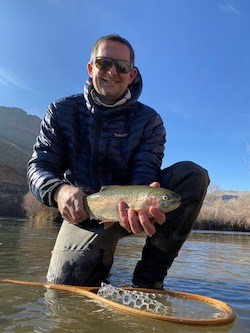
About the Author
My name's Sam and I'm a fly fishing enthusiast just like you. I get out onto the water 80+ times each year, whether it's blazing hot or snow is falling. I enjoy chasing everything from brown trout to snook, and exploring new waters is something I savor. My goal is to discover something new each time I hit the water. Along those lines, I record everything I learn in my fly fishing journal so I can share it with you.
Follow me on Instagram , YouTube, and Facebook to see pictures and videos of my catches and other fishing adventures!
